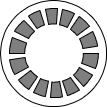D. Stereovision
1. Not Seeing Double
Stereophotography allows us to obtain 3D information from 2D images. So how is that possible? Those of us with bi-cameral vision can see in 3D because we have two eyes separated by a nose (the nose is more than just a smelling organ). That means we see the same objects from two different perspectives: left and right. This is called stereovision. If you close one eye, your view is no longer 3D - you might think it still is, but your mind is used to "filling in the details" to interpret in 3D what your single eye sees in 2D.
Did you ever have a GAF Viewmaster TM as a kid? (I'm dating myself). It was a binocular-type device in which a round disk was inserted, Figure D-1.
 |
 |
| (a) Viewer | (b) Image disk |
| Figure D-1 Viewmaster System |
|
On opposite edges of the disk were paired slides of the same scene from slightly different perspectives. Looking through the Viewmaster eyepieces you would see a single 3D image. Each eye was forced to look at a different image.
Similarly, if you ever went to one of those horrid 3D movies, you were given a pair of cheap paper-frame glasses having one red lens and one blue lens, Figure D-2.
 |
| Figure D-2 3D Glasses |
Wearing the glasses (supposedly) allowed seeing 3D movie effects.The movie was filmed simultaneously from two perspectives, with one camera using a red filter, the other blue. When viewing the movies with the glasses, the red-filtered eye was forced to see one image, the blue-filtered the other. Without the glasses, the movie looked blurry. Most of the time it didn't work too well because peoples' eye geometry and eyesight vary too much. 3D movies' biggest success was creating headaches. Using red and blue filters is known as an anaglyphic viewing system. A related system used polarized lenses with lens polarization 90° apart.